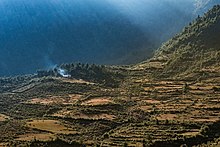Community-based economics or community economics is an economic system that encourages local substitution. It is similar to the lifeways of those practicing voluntary simplicity, including traditional Mennonite, Amish, and modern eco-village communities. It is also a subject in urban economics, related to moral purchasing and local purchasing.

The Center for International Forestry Research (CIFOR) is a non-profit scientific research organization that conducts research on the use and management of forests with a focus on tropical forests in developing countries. CIFOR, which merged with World Agroforestry on Jan. 1, 2019, is the forestry and agroforestry research center of the Consultative Group on International Agricultural Research (CGIAR), a network of 15 research centers around the world that focus on agricultural research for sustainable development, working closely with governments and other partners to help develop evidence-based solutions to problems related to sustainable agriculture and natural resource management.

Forestry laws govern activities in designated forest lands, most commonly with respect to forest management and timber harvesting. Forestry laws generally adopt management policies for public forest resources, such as multiple use and sustained yield. Forest management is split between private and public management, with public forests being sovereign property of the State. Forestry laws are now considered an international affair.

Natural resource management (NRM) is the management of natural resources such as land, water, soil, plants and animals, with a particular focus on how management affects the quality of life for both present and future generations (stewardship).

Deforestation in Cambodia has increased in recent years. Cambodia is one of the world's most forest endowed countries, that was not historically widely deforested. However, massive deforestation for economic development threatens its forests and ecosystems. As of 2015, the country has one of the highest rates of deforestation in the world.
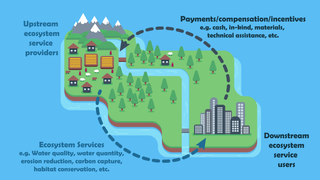
Payments for ecosystem services (PES), also known as payments for environmental services, are incentives offered to farmers or landowners in exchange for managing their land to provide some sort of ecological service. They have been defined as "a transparent system for the additional provision of environmental services through conditional payments to voluntary providers". These programmes promote the conservation of natural resources in the marketplace.
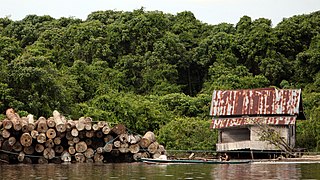
Overlogging is a form of overexploitation caused by legal or illegal logging activities that lead to unsustainable or irrecoverable deforestation and permanent habitat destruction for forest wildlife.

Community forestry is an evolving branch of forestry whereby the local community plays a significant role in forest management and land use decision making by themselves in the facilitating support of government as well as change agents. It involves the participation and collaboration of various stakeholders including community, government and non-governmental organisations (NGOs). The level of involvement of each of these groups is dependent on the specific community forest project, the management system in use and the region. It gained prominence in the mid-1970s and examples of community forestry can now be seen in many countries including Nepal, Indonesia, Korea, Brazil, India and North America.

Environmental issues are disruptions in the usual function of ecosystems. Further, these issues can be caused by humans or they can be natural. These issues are considered serious when the ecosystem cannot recover in the present situation, and catastrophic if the ecosystem is projected to certainly collapse.
Community-based management (CBM) is a bottom up approach of organization which can be facilitated by an upper government or NGO structure but it aims for local stakeholder participation in the planning, research, development, management and policy making for a community as a whole. The decentralization of managing tactics enables local people to deal with the unique social, political and ecological problems their community might face and find solutions ideal to their situation. Overwhelming national or local economic, political and social pressures can affect the efficiency of CBM as well as its long term application. CBM varies across spatial and temporal scales to reflect the ever-changing distinctive physical and/or human environment it is acting within. While the specifics of each practice might differ, existing research maintains that community based management, when implemented properly, is incredibly beneficial not only for the health of the environment, but also for the well-being of the stakeholders.

The Guarayos are an indigenous group living in their ancestral land in eastern Bolivia. They are located north of the department of Santa Cruz. The current population of the Guarayo group in Bolivia is 12,000. They primarily speak Guarayu, and 70% of the population is Roman Catholic with the remaining 30% practicing ethnic religions. Guarayu comes from the language of Guaraní as it belongs in the Tupí Family. They are known to be predominantly agricultural as much of their culture and lifestyle relies on their land.
The Mid-Himalayan Watershed Development Project (MHWDP) is a 222,951 ha land husbandry initiative in Himachal Pradesh, India, that aims by means of green growth and sustainable development to establish a functionally tenable watershed ecosystem. MHWDP has started to reverse several decades of degradation of the natural resource base including forests, has achieved improved agricultural yields and productivity, and has raised rural household incomes. It includes the Himachal Pradesh Reforestation Project (HPRF), the world's largest clean development mechanism (CDM) project.
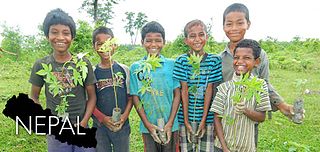
Climate change in Nepal is a major problem for Nepal as it is one of the most vulnerable countries to the effects of climate change. Globally, Nepal is ranked fourth, in terms of vulnerability to climate change. Floods spread across the foothills of the Himalayas and bring landslides, leaving tens of thousands of houses and vast areas of farmland and roads destroyed. In the 2020 edition of Germanwatch's Climate Risk Index, it was judged to be the ninth hardest-hit nation by climate calamities during the period 1999 to 2018. Nepal is a least developed country, with 28.6 percent of the population living in multidimensional poverty. Analysis of trends from 1971 to 2014 by the Department of Hydrology and Meteorology (DHM) shows that the average annual maximum temperature has been increasing by 0.056 °C per year. Precipitation extremes are found to be increasing. A national-level survey on the perception-based survey on climate change reported that locals accurately perceived the shifts in temperature but their perceptions of precipitation change did not converge with the instrumental records. Data reveals that more than 80 percent of property loss due to disasters is attributable to climate hazards, particularly water-related events such as floods, landslides and glacial lake outburst floods (GLOFs).
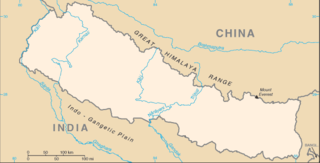
Deforestation in Nepal has always been a serious issue, which has a severe effect on the lives of poor people. In the past, Nepal was a widely forested nation. However now with the requirement for the extension of rural areas, migration of hills people to the plains, the developing regional interest for timber, and the local residents dependence on firewood as the essential source of energy, less than 30% of the nation's forest cover remains. Due to the continuous deforestation in Nepal, many people and creatures are dying. Around 70 percent of the people in Nepal work in agriculture, even if it is difficult to farm in the prevailing unfavourable weather conditions.

Bamboo forestry is a cultivation and raw material industry that provides the raw materials for the broader bamboo industry, worth over 72 billion dollars globally in 2019.

Carbon farming is a name for a variety of agricultural methods aimed at sequestering atmospheric carbon into the soil and in crop roots, wood and leaves. The aim of carbon farming is to increase the rate at which carbon is sequestered into soil and plant material with the goal of creating a net loss of carbon from the atmosphere. Increasing a soil's organic matter content can aid plant growth, increase total carbon content, improve soil water retention capacity and reduce fertilizer use. Carbon farming is one component of climate smart agriculture.
Community Based Mangrove Management (CBMM) is a sustainable approach for conserving the rapidly disappearing mangrove forests. It can be defined as community driven management and rehabilitation of mangrove forests involving resource users in the management process directly. CBMM decentralizes authority and power from government to local communities. The dual aim of CBMM is the ongoing conservation of mangroves and generation of sustainable livelihood.

Ann M. Bartuska is an ecologist and biologist. She is a senior advisor at Resources for the Future and a former Deputy Under Secretary for Research, Education, and Economics (REE) at the United States Department of Agriculture and former USDA Chief Scientist.

Environmental conflicts or ecological distribution conflicts (EDCs) are social conflicts caused by environmental degradation or by unequal distribution of environmental resources. The Environmental Justice Atlas documented 3,100 environmental conflicts worldwide as of April 2020 and emphasised that many more conflicts remained undocumented. Parties involved in these conflicts include locally affected communities, states, companies and investors, and social or environmental movements; typically environmental defenders are protecting their homelands from resource extraction or hazardous waste disposal. Resource extraction and hazardous waste activities often create resource scarcities, pollute the environment, and degrade the living space for humans and nature, resulting in conflict. A particular case of environmental conflicts are forestry conflicts, or forest conflicts which "are broadly viewed as struggles of varying intensity between interest groups, over values and issues related to forest policy and the use of forest resources". In the last decades, a growing number of these have been identified globally.
Environmentalism of the poor is a set of social movements that arise from environmental conflicts when impoverished people struggle against powerful state or private interests that threaten their livelihood, health, sovereignty, and culture. Part of the global environmental justice movement, it differs from mainstream environmentalism by emphasizing social justice issues instead of emphasizing conservation and eco-efficiency. It is becoming an increasingly important force for global sustainability.


